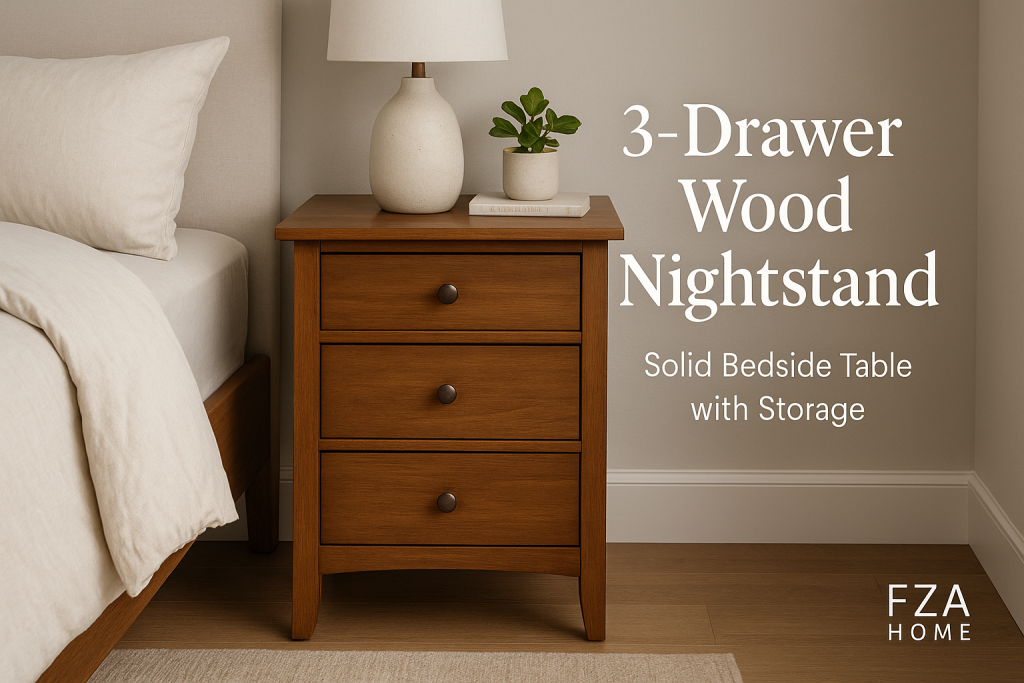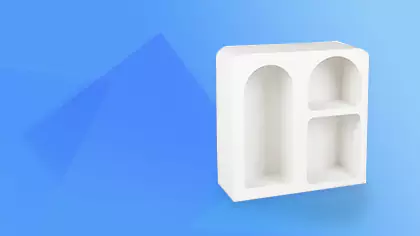
As specialists in high-quality home furnishings with years of experience analyzing furniture construction and design, we understand that a nightstand is more than just a place to set a lamp. It’s a crucial piece of bedroom furniture that blends functionality, storage, and style. The single best choice for maximizing these three elements is the 3-drawer wood nightstand. It offers unparalleled storage capacity, the timeless beauty of natural wood, and the durability to last for decades, making it a superior investment for any bedroom.
This comprehensive guide explores every aspect of choosing, styling, and maintaining the perfect 3-drawer wood bedside table. We will delve into the types of wood, construction quality, design integration, and answer the most common questions our customers ask.
Why Trust Our Expertise?
Our team has spent years sourcing, evaluating, and curating collections of fine wooden furniture. We’ve assessed hundreds of designs, from mass-produced items to artisan-crafted pieces. This article is a culmination of our collective knowledge in material science, interior design principles, and practical furniture use, designed to empower you to make an informed and confident decision for your home.
The Unbeatable Advantages of a 3-Drawer Design
When selecting a bedside table, the number of drawers directly impacts its utility. While one or two drawers can suffice, a three-drawer configuration elevates the piece from simple storage to a truly functional organizational hub.
- Unmatched Storage Capacity: This is the most obvious benefit. A 3-drawer nightstand allows you to neatly segment your belongings. The top drawer is perfect for daily essentials like charging cables, reading glasses, and hand cream. The middle drawer can hold books, journals, or medication, while the bottom drawer is ideal for less-frequently used items, keeping your bedside area completely clutter-free.
- Enhanced Visual Substance: A taller, more substantial 3-drawer unit provides a stronger visual anchor next to a bed, especially larger queen or king-sized frames. It creates a sense of balance and proportion that smaller tables can’t achieve.
- Timeless Functionality: This design isn’t a fleeting trend. For centuries, chests of drawers have been a staple of functional furniture. A 3-drawer nightstand carries this heritage of practicality, ensuring it will remain useful and relevant for its entire lifespan.
- Versatility Beyond the Bedroom: While designed as a bedside table, its ample storage makes it incredibly versatile. It can function as an end table in a living room, a storage unit in a home office, or an accent chest in a hallway.
Decoding the Wood: What is the Best Material for a Durable Nightstand?
The term “wood nightstand” can describe a wide range of materials. Understanding the difference between solid wood and engineered wood is the most critical step in choosing a piece that will last.
Solid Wood: The Gold Standard
Solid wood furniture is constructed entirely from natural lumber—oak, maple, walnut, pine, etc. It is the premium choice for its strength, longevity, and unique beauty.
- Durability: It is incredibly strong and can withstand decades of use. Scratches and dents can be sanded down and refinished, a repair not possible with veneered products.
- Aesthetics: Every piece of solid wood has a unique grain pattern, making your nightstand a one-of-a-kind item. It develops a rich patina over time, adding to its character.
- Value: While the initial cost is higher, solid wood furniture is a long-term investment that retains its value far better than its engineered counterparts.
Engineered Wood: Understanding the Alternatives
Engineered wood products like MDF (Medium-Density Fiberboard) and particleboard are made from wood fibers, sawdust, and adhesives, often covered with a thin veneer of real wood or laminate.
| Feature | Solid Wood | MDF (Medium-Density Fiberboard) |
| Composition | 100% natural lumber | Wood fibers, wax, and resin pressed together |
| Durability | Excellent; can last for generations | Good; denser and stronger than particleboard |
| Moisture Resistance | Varies by wood and finish; can warp | Prone to swelling and damage if veneer is broken |
| Repairability | High; can be sanded and refinished | Low; deep scratches are permanent |
| Weight | Heavy and substantial | Very heavy and dense |
| Cost | High | Low to Moderate |
Export to Sheets
Our Recommendation: For a piece of furniture you interact with daily like a nightstand, the durability and tactile quality of solid wood are unmatched. It is the superior choice for a “buy it for life” product.
Popular Wood Types and Their Characteristics
- Oak: Known for its prominent grain and exceptional hardness, oak is a traditional favorite. It’s highly resistant to scratches and wear, making it perfect for a high-use item.
- Walnut: Prized for its rich, dark color and smooth, straight grain. Walnut lends a sense of luxury and sophistication, making it a perfect fit for modern wood nightstands that aim for an elegant, contemporary feel.
- Maple: With its subtle, creamy-white to light reddish-brown hue and minimal grain, maple is incredibly strong and durable. Its light color makes it exceptionally versatile. If you’re considering a lighter wood tone, our guide on choosing a maple nightstand offers a deeper look into its unique benefits and styling potential.
- Pine: A softer wood with a rustic, often knotty appearance. Pine is more affordable but is also more susceptible to dents and scratches. It’s a great choice for farmhouse or cottage-style decor.
The Anatomy of a High-Quality Nightstand: What to Look For
Beyond the primary material, the construction details separate a well-made nightstand from a mediocre one.
Drawer Construction: The Telltale Sign of Quality
How the drawers are joined together is a crucial indicator of craftsmanship.
- Dovetail Joints: This is the hallmark of high-quality furniture. Interlocking “pins” and “tails” create an incredibly strong, durable joint that resists being pulled apart. It requires skill and precision to create.
- Stapled or Glued Butt Joints: In lower-quality pieces, the drawer sides are simply glued or stapled together. These joints are weak and are prone to failing over time with repeated opening and closing.
Pro Tip: Always try to open a drawer and inspect the corners. The presence of dovetail joints is a clear sign of superior build quality.
Hardware and Finishes
- Drawer Glides: High-quality nightstands feature smooth, full-extension metal glides. These allow the drawer to open effortlessly and fully, giving you easy access to the entire space. Cheaper models may use wood-on-wood glides or simple plastic rollers that can stick or break.
- Knobs and Pulls: The hardware should feel substantial and be securely attached. This is an easy element to customize to better match your decor, but the starting quality matters.
- The Finish: A quality finish not only provides the color but also protects the wood. Look for an even, smooth application without drips or bubbles. Whether it’s a clear lacquer that showcases the natural grain or a painted finish, it should be durable. For painted options, a classic white or off-white can brighten a room significantly. For insights on incorporating these tones, explore our guides on white 3-drawer nightstand styles and our comprehensive off-white nightstand guide.
How Do I Style a 3-Drawer Nightstand in My Bedroom?
A 3-drawer nightstand offers a generous surface for styling. The key is to create a display that is both beautiful and functional, without appearing cluttered.
Achieving Balance and Scale
The golden rule for nightstand height is that its top surface should be level with or slightly above the top of your mattress. This makes it easy to reach for items from bed. The substantial size of a 3-drawer unit naturally works well with thicker mattresses and taller bed frames.
Essential Styling Elements
Even if you have limited space, you can create a beautiful arrangement. Our guide on how to style a small nightstand has principles that apply here as well. Follow this simple formula for a perfectly balanced look:
- Start with an Anchor: The Lamp. Choose a lamp that is proportionate to the nightstand’s surface area. It should provide adequate light for reading without overwhelming the space.
- Add Vertical Height. Place a small stack of books, a slender vase with a few stems, or a tall, framed photo next to the lamp. This draws the eye upward and creates visual interest.
- Incorporate a Living Element. A small potted plant like a succulent or a fresh flower instantly adds life and color to the arrangement.
- Include a Personal Item. A favorite scented candle, a unique trinket from your travels, or a beautiful ceramic dish to hold jewelry makes the space feel personal and curated.
- Maintain a Functional Landing Spot. Always leave a clear space for your phone, a glass of water, or the book you are currently reading.
Integrating Your Nightstand with Different Interior Design Styles
The versatility of wood allows a 3-drawer nightstand to fit seamlessly into virtually any decor scheme.
- Modern and Minimalist: Choose a nightstand with clean lines, a sleek, unadorned surface, and minimal hardware. Woods like walnut or maple with a smooth, natural finish are ideal.
- Rustic and Farmhouse: Embrace woods with character, like knotty pine or reclaimed oak. A slightly distressed finish and robust, dark metal hardware will complete the look.
- Classic and Traditional: Opt for elegant woods like cherry or mahogany. Look for pieces with refined details like beveled edges, bracket feet, and classic brass or bronze hardware.
- Scandinavian: A light-colored wood like maple or ash is perfect. The design should emphasize simplicity, clean lines, and functionality, often with tapered legs and simple, cut-out drawer pulls.
Care and Maintenance: Protecting Your Investment
A solid wood nightstand can last a lifetime with proper care.
- Regular Dusting: Use a soft, lint-free cloth to dust the surface regularly.
- Clean Spills Immediately: Use a slightly damp cloth to wipe up spills, then dry immediately with a clean cloth to prevent water spots.
- Avoid Harsh Chemicals: Do not use all-purpose cleaners or abrasive polishes, as they can damage the wood’s finish.
- Use Coasters: Protect the surface from moisture rings by always placing drinks on a coaster.
- Control Humidity: Extreme changes in humidity can cause wood to swell or shrink. Try to maintain a stable environment in your home.
Frequently Asked Questions (FAQ)
Q: What is the ideal height for a 3-drawer nightstand?
A: The ideal height for any nightstand is to be roughly level with the top of your mattress when made. For most modern beds, this falls between 24 and 28 inches. A 3-drawer nightstand naturally fits within this range, making it a perfect ergonomic choice.
Q: Can a 3-drawer nightstand be too big for my room?
A: While they are more substantial, their footprint (width and depth) is often standard. Measure your available space next to the bed, ensuring you have at least 2-3 inches of breathing room between the nightstand and the bed frame or any adjacent wall. The added vertical storage often saves space elsewhere.
Q: Is solid wood always better than MDF for a nightstand?
A: For longevity, repairability, and long-term value, solid wood is definitively the superior material for a frequently used piece like a nightstand. High-quality MDF can be a good budget-friendly option for less-used accent furniture, but it lacks the durability and timeless appeal of real wood.
Q: How do I match a wood nightstand to my existing bed frame?
A: You have two main options: matching or coordinating. You can choose a nightstand made from the same wood and finish as your bed for a cohesive look. Alternatively, for a more modern, curated feel, you can choose a coordinating piece. For example, pair a metal bed frame with a warm oak nightstand, or a light-colored upholstered bed with a dark walnut nightstand for a beautiful contrast.
Q: How much weight can the top of a wood nightstand hold?
A: A well-constructed solid wood nightstand can easily hold the weight of a heavy lamp, a stack of books, and other decorative items, typically up to 50-60 pounds without any issue. Always refer to the manufacturer’s specifications if you plan to place an unusually heavy object on it.











